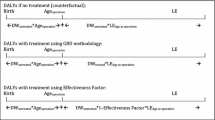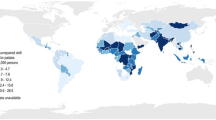Abstract
Background
Assessing burden of disease encompasses the prevalence of disease entities, but it is the impact that affects the populace. Similarly, optimal evaluation of intervention programs shows impact rather than simply an enumeration of services. Economic effects are a fungible measure but are difficult to assess. Modeling of economic effects was used to evaluate a cleft program in Nepal and to demonstrate impact of alleviating this subset of the surgical burden of disease.
Methods
The database of patients who underwent care at a cleft center in Katmandu in 2005 was used. Disability adjusted life years averted were calculated. Using both GNI per capita and Value of a Statistical Life, the economic value to the individuals and to society was calculated.
Results
The two methods yielded a conservative and a generous estimate of economic impact of treating cleft lip and palate. Using GNI per capita, cleft lip repair added between $856 and $6,598 to lifetime individual income. For cleft palate, this ranged from $2,293 to $17,278. Using Value of a Statistical Life, cleft lip repair added between $56,919 and $143,363, and cleft palate between $152,372 and $375,412.
Conclusions
The immense economic gain realized by an intervention addressing a small proportion of the surgical burden of disease indicates the importance of these conditions to public health and well-being. This methodology also lends itself to broader use and to further refinement as a means of evaluation of interventions. This has implications for health policy and for funding and resource allocation for surgical conditions in the developing world.

Similar content being viewed by others
Notes
Purchasing Power Parity considers the varying prices of goods between national economies; the Atlas method of computing Gross National Income measures income in terms of currency equivalents, but also considers fluctuations in exchange rates. See http://www.who.int/choice/costs/ppp/en/ for more information on PPP and http://web.worldbank.org/WBSITE/EXTERNAL/DATASTATISTICS/0,,contentMDK:20173256~isCURL:Y~menuPK:64133156~pagePK:64133150~piPK:64133175~theSitePK:239419,00.html for more information on economic assessment of countries.
References
Debas HT, Gosselin R, McCord C, Thind A (2006) Surgery. In: Jamison D (ed) Disease control priorities in developing countries, 2nd edn. Oxford University Press, New York, pp 1245–1259
Ozgediz D, Jamison D, Cherian M, McQueen K (2008) The burden of surgical conditions and access to surgical care in low- and middle-income countries. Bull World Health Organ 86:646–647
Weiser TG et al (2008) An estimation of the global volume of surgery: a modeling strategy based on available data. Lancet 372:139–144
Dempsey M (1947) Decline in tuberculosis: the death rate fails to tell the entire story. Am Rev Tuberculosis 56:157-164; cited in: Mathers CD, Vos T, Lopez AD, Salomon J, Ezzati M (eds) (2001) National Burden of Disease Studies: a practical guide. Edition 2.0. Global Program on Evidence for Health Policy. World Health Organization, Geneva
Murray CJL, Frenk J (2008) Health metrics and evaluation: strengthening the science. Lancet 371:1191–1199
Murray CJL, Lopez AD, Jamison DT (1994) The global burden of disease in 1990: summary results, sensitivity analysis and future directions. Bull World Health Organ 72:445–459
Murray CJL, Lopez AD (1997) Global mortality, disability and the contribution of risk factors: global burden of disease study. Lancet 349:1436–1442
Murray CJL, Lopez AD (eds) (1996) The global burden of disease: a comprehensive assessment of mortality and disability from diseases, injuries, and risk factors in 1990 and projected to 2020. Harvard University Press on behalf of the World Health Organization and the World Bank, Cambridge
Lopez AD, Mathers CD, Ezzati M, Jamison DT, Murray CJL (2006) Global burden of disease and risk factors. Oxford University Press and The World Bank
Lopez AD, Mathers CD, Ezzati M, Jamison DT, Murray CJL (2006) Global burden of disease and risk factors: systematic analysis of population health data. Lancet 367:1747–1757
The Global Burden of Diseases, Injuries, and Risk Factors Study Operations Manual Final Draft January 31, 2008. http://www.globalburden.org/GBD_Study_Operations_Manual_Jan_31_2008.pdf. Accessed 19 Nov 2008
Lopez AD, Mathers CD, Ezzati M, Jamison DT, Murray CJL (2006) Global burden of disease and risk factors. Oxford University Press and The World Bank, p 153
Murray CJL, Lopez AD (1994) Quantifying disability: data, methods and results. Bull World Health Organ 72:481–494
Murray CJL (1994) Quantifying the burden of disease: the technical basis for disability-adjusted life years. Bull World Health Organ 72:425–445
Anand S, Hanson K (1997) Disability-adjusted life years: a critical review. J Health Econ 16:685–702
Williams A (1999) Calculating the global burden of disease: time for a strategic reappraisal? Health Econ 8:1–8
Murray CJL, Lopez AD (2000) Progress and directions in refining the global burden of disease approach: a response to Williams. Health Econ 9:69–82
Shanmugan KR (2001) Self-selection bias in the estimates of compensating differentials for job risks in India. J Risk Uncertain 22:263–275
Bloom D, Canning D, Sevilla J (2004) The effect of health on economic growth: a production function approach. World Development 32(1):1. (Cited in Bloom D, Canning D, Weston M, The value of vaccination. World Economics 6:15–39)
Becker GS, Phillipson TJ, Soares RR (2005) The quantity and quality of life and the evolution of world inequality. NBER Working Paper No. 9765
Barro RJ (1991) Economic growth in a cross section of countries. Q J Econ 106:407–443 (cited in Bils and Klenow)
Bils M, Klenow PJ (2000) Does schooling cause growth? Am Econ Rev 90:1160–1183
Acemoglu D, Angrist J (1999) How large are the social returns to education? Evidence from compulsory schooling laws, Working paper 7444, National Bureau of Economic Research; http://www.nber.org/papers/w7444
Ashraf QH, Lester A, Weil DN (2008) When does improving health raise GDP? Presented at Harvard School of Public Health, February 12, 2007; published as Ashraf QH, Lester A, Weil DN (2008) When does improving health raise GDP? NBER Working Paper W14449. http://www.org/papers/w14449
Hall RE, Jones CI (1999) Why do some countries produce so much more output per worker than others? Q J Econ 114:83–116
Thaler R, Rosen S (1975) The value of saving a life: evidence from the labor market. In: Terlekyj N (ed) Household production and consumption. Columbia University Press, New York, pp 265–298
Moore MJ, Viscusi WK (1998) The quantity-adjusted value of life. Econ Inq 26:369–388
Viscusi WK, Aldy JE (2003) The value of a statistical life: a critical review of market estimates throughout the world. J Risk Uncertain 27:5–76
Aldy JE, Viscusi WK (2007) Age differences in the value of statistical life: revealed preference evidence. Resources for the Future, Discussion Paper 07-05
Mathers CD, Salomon JA, Ezzati M (2006) Sensitivity and uncertainty analyses for burden of disease and risk factor estimates. In: Lopez AD, Mathers CD, Ezzati M et al (eds) Global burden of disease and risk factors. Oxford University Press and The World Bank, p 417
Edejer TT, Evans D, Lowe J (2002) WHR p 108. http://www.who.int/whr/2002/en/whr02_en.pdf
WHO (2001) Macroeconomics and health: investing in health for economic development. In: Sachs JD (ed) Report of the Commission on Macroeconomics and Health. World Health Organization, p 32
Acknowledgments
The author acknowledges the contributions to this work of Dr. Shankar Man Rai and Dr. Kiran Nakarmi of the Interplast Surgical Outreach Program at Katmandu Model Hospital, Katmandu, Nepal.
Author information
Authors and Affiliations
Corresponding author
Rights and permissions
About this article
Cite this article
Corlew, D.S. Estimation of Impact of Surgical Disease Through Economic Modeling of Cleft Lip and Palate Care. World J Surg 34, 391–396 (2010). https://doi.org/10.1007/s00268-009-0198-9
Published:
Issue Date:
DOI: https://doi.org/10.1007/s00268-009-0198-9




